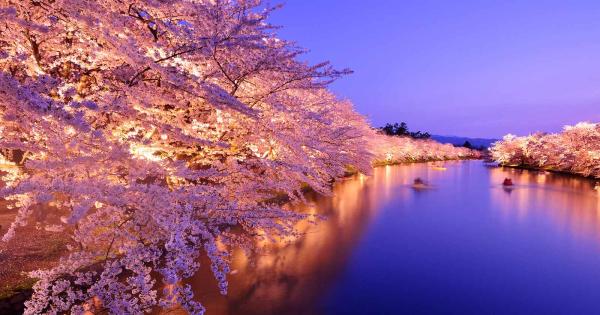Sakura sakura
Sakura sakura
Yayoi no sora wa
Miwatasu kagiri
Kasumi ka kumo ka
Nioi zo izuru
Iza ya iza ya
Mi ni yukanSakura sakura
Noyama mo sato mo
Miwatasu kagiri
Kasumi ka kumo ka
Asahi ni niou
Sakura sakura
Hana zakariLyricist & Composer:Unkown
in 1888
Cherry blossoms, cherry blossoms
Cherry blossoms, cherry blossoms,
In the spring sky,
As far as the eye can see.
Are they mist, or are they clouds?
Fragrant scents are borne upon the breeze.
Come now, let’s go,
To see them for ourselves.
Cherry blossoms, cherry blossoms,
In fields, mountains, and villages,
As far as the eye can see.
Are they mist, or are they clouds?
Fragrant in the morning sun.
Cherry blossoms, cherry blossoms,
Flowers in full bloom.

Sakura is symbol of Spring in Japan
“Sakura Sakura” symbolizes spring in Japan. It is said that this song became popular when it was used in the first act of the opera “Madame Butterfly” by Italian composer Puccini in 1904. Since then, it is often performed by foreign musicians, especially rock musicians, when they visit Japan to communicate with the audience.
Historical Background and Evolution of Lyrics
The history of this song dates back to the late Edo period, and it seems to have been popular as a koto practice piece. The title is simply “Sakura,” but in the 1888 “Nihon Sokyokushu,” the lyrics begin with “Sakura Sakura,” and this name is often used. At the time, the lyrics were the second stanza above, but in the 1941 song collection “Uta no Hon,” it was changed to the first stanza. It is speculated that this was because the literary nature of the words may be difficult for children to understand. This may be because literary words may be difficult for children to understand, but in modern times, the words are mixed depending on the generation that learned it.
Although often labeled as a traditional Japanese folk song, “Sakura Sakura” was actually composed in the late Edo period in Edo (modern-day Tokyo) as a practice piece for children learning to play the koto. It was later included in the “Soukyokushuu” (Koto Music Collection) of the “Ongaku Torirabegakari,” a music education institution under the Ministry of Education that existed from 1879 to 1887, and was officially published in 1888.

Cultural Significance and Spirituality of Cherry Blossoms
The reason this song has taken root in the hearts of Japanese people is probably because the graceful melody matches the image of cherry blossoms. Cherry blossoms and autumn leaves are representative of Japanese nature, but the latter can be enjoyed for more than a month, while cherry blossoms can only be enjoyed for two weeks at most. This is probably because cherry blossoms resonate with the spirituality and sense of impermanence of the Japanese people. Many people gather at cherry blossom viewing spots during this season, laying out picnic sheets. However, for drunk cherry blossom viewers (including me), being able to drink alcohol from noon on a calm day is probably more important than that feeling.

At Chidorigafuchi, adjacent to the Nippon Budokan, you can enjoy cherry blossom viewing from a boat.
Theory of Hebrew Origin and Its Context
By the way, there is a theory that this song was originally Hebrew. Some enthusiasts and researchers claim that the word “sakura” resembles a Hebrew word. During the Edo period, Japan had a policy of national isolation, and exchange with the outside world was extremely limited, there was almost no contact with Hebrew-speaking communities (such as Jews), and there is no record of a Jewish community being formed in Japan until the 20th century. But there is also a tomb of Christ in Aomori Prefecture, Japan. Believe it or not?
▼Tokyo Hanami spot
▼Osaka Hanami spot
▼Kyoto Hanami spot

▼Hanami Item







コメント